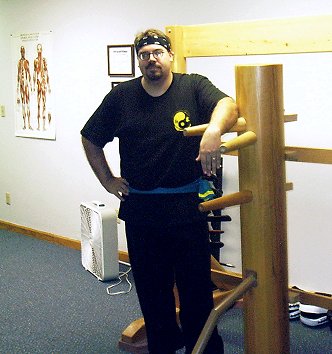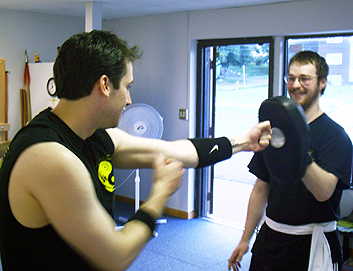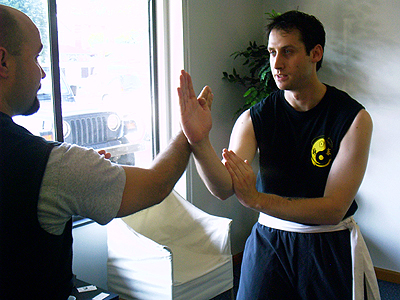its paid sponsors, whose products you need!
“Stay ‘unreasonable.’ If you
don’t like the solutions [available to you], come up with your
own.”
Dan Webre
The Martialist does not
constitute legal advice. It is for ENTERTAINMENT
PURPOSES ONLY.
Copyright © 2003-2004 Phil Elmore, all rights
reserved.
Discovering Wing Chun
By Phil Elmore
(Originally published in
MartialTalk magazine.
Special thanks are due to Bob Hubbard)
When the
Syracuse Wing Chun
Academy opened in my adopted hometown, I knew precious little about Wing
Chun Kung Fu specifically or the Chinese Martial Arts (CMA) in general. I had
vague ideas that Wing Chun was associated with lowline kicks, locked elbows, and
traditionalism. I knew that Bruce Lee had studied Wing Chun before coming to
the United States and that he had criticized it as too “rigid.” That, however,
was the extent of my knowledge — apart from an overwhelming desire to study the
art.
I have my lovely wife to thank for my involvement with the
Syracuse Wing Chun Academy. She was reading the paper one September evening
when she noticed an article I missed, detailing the new martial arts school
opening in the city. Moments after she showed me the article, I was on the
phone to Sifu Anthony Iglesias.

Phil Elmore (left) and Sifu Anthony Iglesias
I have since heard Sifu Iglesias speak with countless
prospective students on the phone. I would give a lot to be able to hear a
recording of my first conversation with him. Endlessly friendly and amazingly
patient, Sifu Iglesias insists that his students call him simply “Anthony.” A
veteran martial artist with years of experience in multiple styles (including
White Crane Kung Fu and Western Boxing), Anthony was clear from the outset
regarding what he expected from his school and his students.
“I don’t believe in attacking other styles or lineages,” he
told me on the phone, something he has since reiterated in many classes. “We do
not limit ourselves. It’s all Wing Chun and we will study it all to
learn what will benefit us in our training. If you meet someone who studies
Wing Chun, don’t start comparing lineages. Be happy to have met a fellow
student and leave it at that.”
The destructive politics of Wing Chun, particular the
lineage disputes in Hong Kong, are well known in martial circles. Often,
practitioners from the William Cheung and Leung Ting lineages do not get along,
for example. Cheung teaches “Traditional Wing Chun,” and it is primarily in his
lineage that Anthony teaches (though he remains open to other lineages and
frequently provides examples of how students of those lineages do techniques
differently). There are indeed stylistic differences between the Cheung
lineage, “Classical Wing Chun,” Ving Tsun or Wing Tsun, and countless other
permutations of spelling and lineage for this Chinese art. The differences
range from the way the three empty-hand Wing Chun forms are performed, to the
positioning of the hands and arms for certain techniques, to the way (and to
what degree of precision) footwork is executed.
Sifu Iglesias demonstrates a wooden dummy form for the
class.
I had more than one e-mail conversation with Sifu Iglesias
before the school opened and was confident that I was dealing with someone who
had a great attitude and outlook on the martial arts. We talked, among other
things, of the need for a “core” martial art — possessing a system on which to
build, as opposed to taking the “buffet” approach to the arts that had been my
preference for the last decade. It was a relatively warm evening in early
October when Anthony held a gathering at the school to welcome new students and
to meet with friends and acquaintances who wished him well in his new business
venture.
The event was well-attended by current and former students
of Sifu Iglesias, who previously taught at Syracuse’s Fu Shaung Temple with Sifu
Danny Hammond. (The Fu Shaung, where various types of Kung Fu were taught, is
now closed). Sifu Hammond gave the new facility a traditional Buddhist
blessing. Sifu Iglesias spent the evening mingling and speaking, as animated as
ever, about Wing Chun and his plans for the school.
It was that night that I acquired my first piece of Wing
Chun knowledge: the purpose of the mook jong, the wooden dummy. For
years I’ve wanted a wooden dummy of my own, with vague ideas about hitting the
thing the way one sees in certain Kung Fu movies. I learned that first night,
however, that the wooden dummy is not a punching bag or a makiwara board (though
it can be used for limited conditioning of the arms). The dummy is used for
training one’s structure, for developing speed and accuracy while
perfecting the positioning of one’s body. Any Kung Fu practitioner who’ll brag
to you about breaking the arms off the dummy, by contrast, obviously doesn’t
know what he or she is doing. (Anyone can break the arms off a traditional
dummy if they try.)

The author and the wooden dummy (right, if you
wondered).
My footwork, which had always been somewhat sloppy, came
under the scrutiny of Sifu Iglesias in the coming weeks and months. I found
Wing Chun footwork to be very precise and very demanding. The pigeon-toed horse
stance in which training occurs (it is not a fighting stance) caused me
great discomfort at first, but I learned over time that this stance helps
develop the muscles (and the instincts) to properly perform the footwork we
do use for fighting. For weeks we began every class by running through a
list of footwork exercises, from simple left to right stance transitions to
“inside bracing” and “outside bracing” moves. We performed circle steps,
triangle steps, side steps, and a long list of others, all while under Anthony’s
watchful eye.

Sifu Iglesias instructs students on proper positioning
for front steps.
A music teacher and guitarist with years of experience
(Anthony, who is something of a “Renaissance man,” performs in a Dave Matthews
tribute band called One Sweet World), Sifu Iglesias is no stranger to
teaching as such. He is firm but encouraging, persistent without nagging.
He’ll quickly point out serious errors but refrain from badgering a student who
is trying (but not yet successfully) to master a new technique or posture,
saving refinements for follow-up classes.
Wing Chun has three empty-hand forms — what I think of as
physical catalogs of techniques, used both to train one’s structure and to
remind one of the techniques used in the art. The first form, sil lim tao
(“little big idea”) is the form taught to all beginning students, the foundation
for Wing Chun. It involves no footwork other than a transition to the horse
stance. (Footwork is covered in later forms.) The second and third forms are
chum kil (“seeking the bridge”) and bil jee (“thrusting fingers).
One of things for which I developed an immediate dislike
in training was chi sao, the “sticky hands” exercise in which Wing Chun
students develop the touch reflexes for which their infighting system is known.
“Chi Sao is important,” Anthony told me. “It is the standard by which other
schools will judge you. After you’ve done it for a while you’ll start to like
it and you’ll understand better what it’s for. I know you don’t believe me
right now, Phil. Just trust me.”
Sifu Iglesias and his senior student, Don Jennings,
practice chi sao.
There are different chi sao drills. I started with
single hand chi sao, for example, which followed a very set pattern of
movements. One student holds his hand in tahn sao, the “dispersing hand.”
Another holds his same-side hand and arm in fook sao, the “hooking” or
“subduing” hand. The student holding a tahn sao executes jing jiang,
a palm strike. The student holding fook sao turns the “hooking hand”
into a jut sao, the “jerking hand.” He then delivers a vertical punch and
the other student uses bon sao, the “wing arm,” to stop the punch from
striking him in the head. This is done repeatedly.
As we progressed we learned to “run” — that is, to circle
around tightly and strike when the other student exerted pressure that he or she
should not be exerting. In this way, sensitivity to the opponent’s movements —
his or her “energy” directed toward you — is developed.
After that came cross-arm chi sao, which starts out
from a position that reminds me of the Bruce Lee and John Saxon fight scenes
during the competition bouts in Enter the Dragon. The goal of each
student is to deliver a light strike from that position while preventing the
other student from doing the same, using a variety of hand techniques — lop
sao to pull the other student’s hand out of the way while delivering a
strike, for example. Cross-arm chi sao feels a lot more like actually
sparring someone, whereas the simpler single-arm chi sao really bored me
at first.
Students at SWCA practice a cross-arm chi sao
drill.
The importance of chi sao drills was driven home to
me during an exercise with Sifu Iglesias involving knives. Using a rubber
knife, I attacked him, while he sought to check my elbows to stop me and counter
my attack. At one point his initial block of my strike missed. His
chi sao sensitivity training allowed him to counter immediately and stop me
from “stabbing” him without conscious thought on his part. He sensed the
“energy” of my missed incoming attack and he reacted accordingly.
Another technique associated with Wing Chun (and also with
Bruce Lee, though many people don’t realize that his use of the technique came
from Wing Chun) is the “one-inch punch.” The one-inch punch is a function of
structure — of learning to align your body’s “gates” for maximum strength on
the punching side. The leg, hip, and arm line up in a specific manner to take
advantage of the body’s mechanics in imparting power to the target.
A typical one-inch punch drill starts with students
pressing their vertical fists against a wall or other immovable object. The
right knee bends and the right hip comes forward as the body twists sharply into
the punch. The left leg stays fairly straight (though if you try this you’ll see
you can’t help but bend it a little). When the students start pushing themselves
away from the wall and feel discomfort in their hands, they know they’re doing
it right.
Moving on, the students strike focus pads held by other
students. A third student stands behind the punching pair to stop the pad-holder
from falling backward. Tremendous power is generated by such punches, both in
“pushing power” and “impact power” techniques.

Students practice their punching using focus mitts.
The first time I did this drill in Wing Chun, my pad-holder
was a very tall, thin young fellow. I am the heaviest student in class, easily
outweighing my instructor by a hundred pounds. Even doing the drill with
imperfect mechanics, you must understand that the majority of your weight is on
the punching side (where it should be).
I sent the young man flying backwards quite spectacularly
— so much so that he switched with someone heavier the next time it was my
turn. This wasn’t because I’m some ham-fisted gorilla (though the charge has
been made) but because of the structure with which the punch is
performed.
We do another relevant drill in Wing Chun — a footwork
drill called the “shifting horse.” This looks a lot like walking: as the left
foot comes forward at an angle, the body shifts on the right heel as the right
fist comes forward in a punch. Then the right foot comes forward as the left
foot shifts on the heel and the left fist comes forward in a punch. This helps
develop Wing Chun punching.
With practice, the one- and no-inch punches can be done
relatively instinctively. If you learn to punch with your body aligned a certain
way, after all, that’s how you’ll do it.
 Wing
Wing
Chun has two weapons forms, including the Baat Jaam Do (butterfly
swords). The butterfly swords are used in pairs and are characterized by wide,
cutting blades and prominent D-guards. They are, in fact, quite similar to
what people picture when they think of “bowie knives,” though the blade shape
does not incorporate the clip-point. (Sifu Iglesias is pictured at right
with his Hanwei butterfly swords, which grace the altar area of the Academy.)
I am nowhere near the point in my training where I would be learning the Baat
Jaam Do form, but weapons training is not neglected at the Syracuse Wing
Chun Academy.
An avid student of the Filipino Martial Arts who works
closely with other instructors, Sifu Iglesias incorporates stick- and
knife-fighting training in his curriculum (as well as defenses to impact weapons
and even firearms). As a knife enthusiast who also appreciates stick fighting
applications, I was extremely pleased to be able to continue training formally
in these methods while also training in Wing Chun.

The author learns a pattern drill with rattan sticks.
Wing Chun, as I’ve come to realize, is an extremely
effective close-quarter fighting system. The principles of Wing Chun —
protecting the centerline, refusing to fight force with force, using two hands
at the same time, using touch reflexes, etc. — are extremely sound and would
complement the practice of almost any other style. Far from being the “rigid”
and “too classical” system described by Bruce Lee in his more negative moments
(Lee actually held his Wing Chun instructors in very high regard and boasted of
their fighting abilities), Wing Chun is actually an extremely dynamic and
efficient art. Relatively straight forward, it can be taught quickly by the
standards of Kung Fu styles and produces [more] effective fighters in a matter
of months.

The author, proud to be a Wing Chun practicioner.
“Without the root,” Sifu Iglesias sometimes quotes, “there is no tree.” Wing
Chun is a superb root system — a traditional art on which a variety of
cross-training can be based to the benefit of the student. It also stands alone
as a complete system for practical, effective self-protection. I have been very
blessed to discover Wing Chun in the course of my training.
The art may be
precisely what you are looking for, too.



